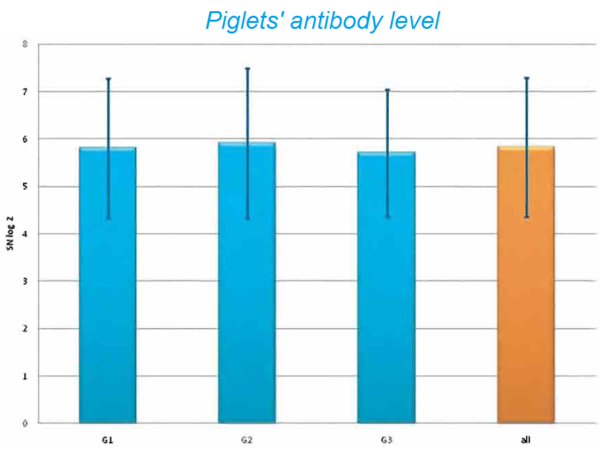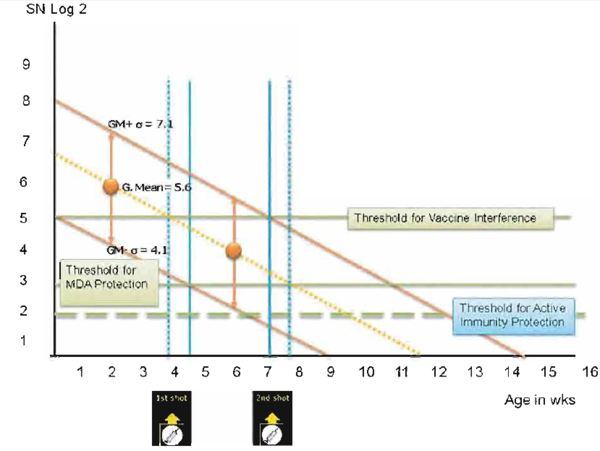.
--> Introduction
--> Results
--> Discusion
--> Conclusion
.
WHAT IS THE BEST VACCINATION PROGRAM WITH COGLAPEST® FOR SOWS?
A NEW STUDY THAT CHANGES THE USUAL CONCEPTS
By Dr Eric Brunier, Regional Market Manager – Swine, Ceva Animal Health Asia Pacific
.
INTRODUCTION
Classical Swine Fever (CSF), or Hog Cholera, is an enzootic threat for the swine industry in Asia, except for Japan. The clinical and economic consequences of this disease are such that no specific measure would lead to a disaster with, as a consequence, the farm disappearance. For these reasons, the vaccination is “compulsory”; when it is not by law it is for viability reasons for the farms.
In the absence of any possible treatment against this viral disease, the only solution is the vaccination. Any sensitive stage must be protected and, in naïve herds, any age is sensitive; including the adults. In enzootic areas, adults have developed some immunity against CSF. This immunity is however heterogeneous depending on each individual contact history with the wild virus. It will at any case never prevent, at the herd level, some infections to happen during the gestation, hence leading to the birth of immune-tolerant piglets that will carry the virus and represent a threat for the remaining of the herd.
The second parameter to consider is that the piglets must be protected from birth onwards. The best solution to provide such an early protection is that their mother provides them a solid maternal protection with a good level of maternal derived antibodies (MDA) in the colostrum. The farm management should allow of course the piglets to drink enough colostrum in the first hour following birth.
For both reasons - sow protection and MDA provision to the piglets - a good CSF prevention commands to vaccinate the breeders (sows and boars). If we consider now that the MDA are able to inactivate the live vaccination strain, we need to wait the MDA level to decrease before starting the vaccination on the piglets. In order to have a coherent vaccination program for the later ones, their MDA level should be as homogeneous as possible. For this reason, as much as the vaccine is totally safe to be used during the gestation, as COGLAPEST® is, it is advisable to vaccinate the sows respecting the same interval between vaccination and farrowing. This delay is between 2 to 6 weeks.
Some farms however, have adopted the mass vaccination technique. This consists of vaccinating all the animals in the farm at the same time: sows, gestating gilts and boars. Only the sows that are in the week between weaning and mating have their vaccination delayed after mating. The advantage of this technique is to ensure good vaccination coverage in the farm, without forgetting any animals and with a perfect regularity between the boosters (usually every four months). Another advantage is that it is easier to mange in a farm (work organization).
The drawback is that the MDA level at birth should be heterogeneous, considering the fact that the sows have been vaccinated at different moments in their cycle; and that could be a limit to a good vaccination program for the piglets.
For these reasons, in collaboration with Mr. Rawat Chantong, Dr. Susichol Sittinuntn and Dr. Thunyatid Sisom, a trial of mass vaccination in a farrow-to-finish farm of 3.000 sows in the south of Thailand has been launched in 2009. This farm was already practicing a mass vaccination program with COGLAPEST® every four months. The objective of the trial was to define whether a vaccination program for the piglets was fully coherent in a situation where sows were vaccinated at different stages of their cycle.
.
MATERIAL AND METHODS
Depending on the last mass vaccination day with COGLAPEST®, 3 groups of 70 sows each have been selected on their expected farrowing date (Figure 1).
- The first group (G1) was selected in order to farrow 20 days after vaccination. This group is representative of what usually happens when we vaccinate sows at the end of gestation.
- The second group (G2) has been selected in order to farrow 63 days after vaccination. This group represents what happens if we do a vaccination in the middle of the gestation.
- The third group (G3) has been selected to farrow 100 days after vaccination. This group represents sows vaccinated at the beginning of the gestation.
For each group, the candidate sows have been sorted by parity range: gilts in first gestation (P0), primiparous sows in second gestation (P1), multiparous sows (P2-P4), older multiparous sows (P>5). In each group, the sows have been selected randomly for each parity range in order to have the same parity ratio in the three groups.
Figure 1: Trial pattern - farrowing time after vaccination for each group
At farrowing, blood was collected from the sows as well as colostrum (mixing colostrum from the right anterior and the right posterior nipples). At 14 days of age, a blood sample has been done on the five first-born correctly drunk the colostrum at birth. On any kind of sample, the antibody level against CSF virus has been measured by serum-neutralization test.
.
RESULTS
Whatever the sample type we consider, mother’s blood, colostrum or piglet blood, the highest level of antibodies is observed in G2 (mid gestation), then in G1 (late gestation) and finally in G3 (early gestation). This is a trend; we can show a statistically significant difference for the G2 and G3 in the colostrum and in the piglets. Vaccinating at the end of the gestation, as it is commonly done, is not the moment to expect the highest level of antibodies in the colostrum for the piglets. It is higher in the middle of the gestation. Other antibody kinetic studies done on pigs showed that the highest level of antibodies is measured about five weeks after vaccination. It would have been interseting to have a group vaccinated 35 days before farrowing.
Table 1: SN mean results
The results coming from gilts and from primiparous sows have been extracted from the general results and studied together. There is no statistically significant difference in the antibody level whatever the sample type or the group considered. The trend seen on the whole herd is weakened with antibody levels almost similar for G1 and G2; slightly lower for G3.
Correlation between the different types of samples has been studied. At the opposite of what we were expecting, the sow’s antibody level at farrowing is not strongly correlated with the antibody level in the colostrum (r2=0.47). It has been surprising to see that the antibody level measured in the colostrum is weakly correlated with the antibody level in the piglets (r2=0.55). At the opposite, we can see a correlation between the sow’s and the piglets antibody level (r2=0.64). If the correlation between mother and piglet was expected, the weak correlation with the colostrum is not logical.
Table 2: Coefficient of determination
.
DISCUSION
The objective of the trial was to determine a coherent vaccination program for the piglets could be defined with a mass vaccination on the breeders. As a preliminary observation, the antibody level in the piglets doesn’t show a big variation between the groups, considering the mean as well as the standard deviation (Graph 1). The vaccination program should be possible.
Graph 1: Piglets’ antibody level in the difference group and standard deviation
For that, the geometrical mean for all the piglets is calculated (5.6 SN log2). The piglets have been samples at two weeks of age; we can define the MDA decaying slope considering the half life of 15 days. When the MDA level is over 5 SN log2 (1:32), the risk these MDA inactivating the vaccine live strain is high; at the opposite, studies from Launais et al. have shown that when the MDA level is over 3 SN log2 (1:8); we may expect a protection against the clinical signs in case of infection. These thresholds determine the vaccination window. In our case, a coherent vaccination program can be defined with a first vaccination just after 4 weeks of age and second one 3 weeks later (Graph 2).
Graph 2: Vaccination time determination
.
CONCLUSION
This trial has confirmed there is a difference in the antibody level in the sows, and hence in the MDA level in the piglets, depending on the vaccination date before farrowing. The highest level of antibody production is seen, in the trial, for the group vaccinated in the middle of the gestation. Considering the normal kinetic aspect of the antibody inscrease after vaccination, the highest level of antibodies may be expected when the vaccination is done about five weeks before farrowing. In order to target the best homogeneity in the MDA for the piglets, we still advise vaccinating all the sows at the same specific moment before farrowing. In the usual range of 2 to 6 weeks before farrowing we advise choosing 5 to 6 weeks before than 2 weeks before.
The mass vaccination, however, is possible and in the case, a coherent vaccination program has been established just after 4 weeks of age with a second injection 3 weeks later.
.
(Source: "Axis Issue 10 - APVS & VIV Asia - Special Edition" - March 2011)
.
<< Back to Classical Swine Fever - Hog Cholera
<< Back to Disease Informations
Related topics: classical swine fever piglet disease informations swine coglapest vaccination prevention sow

 Corporate Website
Corporate Website
 Africa
Africa
 Argentina
Argentina
 Asia
Asia
 Australia
Australia
 Belgium
Belgium
 Brazil
Brazil
 Bulgaria
Bulgaria
 Canada (EN)
Canada (EN)
 Chile
Chile
 China
China
 Colombia
Colombia
 Denmark
Denmark
 Egypt
Egypt
 France
France
 Germany
Germany
 Greece
Greece
 Hungary
Hungary
 Indonesia
Indonesia
 Italia
Italia
 India
India
 Japan
Japan
 Korea
Korea
 Malaysia
Malaysia
 Mexico
Mexico
 Middle East
Middle East
 Netherlands
Netherlands
 Peru
Peru
 Philippines
Philippines
 Poland
Poland
 Portugal
Portugal
 Romania
Romania
 Russia
Russia
 South Africa
South Africa
 Spain
Spain
 Sweden
Sweden
 Thailand
Thailand
 Tunisia
Tunisia
 Turkey
Turkey
 Ukraine
Ukraine
 United Kingdom
United Kingdom
 USA
USA
 Vietnam
Vietnam










